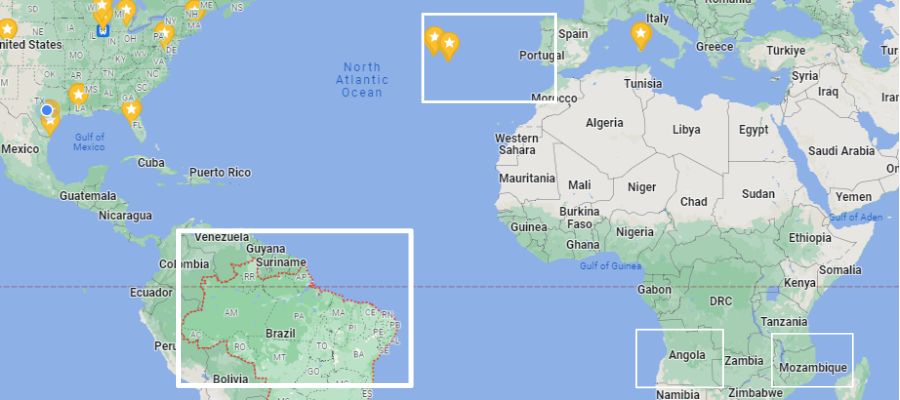The Portuguese language is a Romance language that is spoken by approximately 215 million people worldwide. It is the official language of Portugal, Brazil, Mozambique, Angola, Cape Verde, Guinea-Bissau, and São Tomé and Príncipe. Portuguese is also widely spoken in other countries like East Timor, Macau, and Goa. This huge global variety of speakers and dialects makes Portuguese speech and language development fascinating but also somewhat of a bear to assess when a child who speaks it is referred for speech testing.
The Portuguese language uses the Latin alphabet, with some additional diacritical marks to indicate pronunciation. The language is known for its nasal sounds and distinctive pronunciation, which can vary depending on the region.
The widespread use of Portuguese around the world can be attributed to the history of Portuguese colonization and trade. Portuguese explorers established trade routes throughout the world in the 15th and 16th centuries, which brought the language to places like Brazil, Mozambique, and Angola. Today, Portuguese is one of the most widely spoken languages in the world, with a growing number of speakers in the United States.
In the United States, Portuguese is spoken by immigrant communities from Portugal, Brazil, and other Portuguese-speaking countries. Many Portuguese immigrants came to the United States in the early 20th century in search of economic opportunities. Today, Portuguese is still spoken in communities throughout the United States, particularly in states like Massachusetts, California, and New Jersey.

Interesting Facts About Portuguese Speech and Language Development
One interesting fact about the Portuguese language is that it has contributed many words and phrases to English. Words like “embassy,” “mosquito,” and “pirate” all have Portuguese origins. Additionally, many words in Portuguese are similar to words in other Romance languages, making it a relatively easy language to learn for speakers of those languages.
Something unique to Portuguese language is that it has many dialects, which can vary greatly depending on the region. In Brazil, for example, there are many regional dialects that differ in terms of pronunciation, grammar, and vocabulary. Similarly, Portuguese spoken in Portugal can be quite different from Portuguese spoken in Angola or Mozambique.
English and Portuguese Speech and Language Development
Portuguese Consonants in Comparison to English
| Portuguese Consonants Not Shared with English | /ʁ/ /ɾ/ /ʎ/ /ɲ/ |
| Portuguese Consonants Shared With English | /p/ /b/ /t/ /d//k/ /g/ /f/ /v/ /s/ /z/ /ʃ/ /m/ /n/ /l / |
| English Consonants Not Shared with Portuguese | /ʒ/ /tʃ/ /dʒ/ /h/ /ŋ/ /j/ /ð/ /θ/ /ɹ/ /w/ |
Portuguese Vowels in Comparison to English
| Portuguese Vowels Not Shared with English | /ɨ/ /ẽ/ /õ/ /ɐ̃/ /ĩ/ /ũ/ |
| Portuguese Vowels Shared With English | /a/ /e/ /i/ /o/ /u/ /ɔ/ /ɛ/ |
| English Vowels Not Shared with Portuguese | /ʊ/ /I/ /æ/ /ʌ/ /ə/ /ɚ/ |
Brazilian Portuguese mostly uses /tʃ/ for T and /dƷ/ for D before the letter [i]. Examples: tíbia [tʃ’ibja] and dígito [dƷ’iʒitu]. These are allophonic variations of [t] and [d] and not additional phonemes. In other words, while in English you have the word “tip” and “chip,” where [t] and [ch] result in different meanings, in Brazilian Portuguese those two sounds do not differentiate meaning.
There is also a third sound for the letter R in Brazilian Portuguese: /ɹ/ before a consonant and at the end of a word. Example: cartógrafo [kɐɹt’ɔgɾɐfo].
Portuguese Developmental Norms
| Age Group | Consonants | Consonant Clusters | Vowels |
|---|---|---|---|
| 3;0-3;5 | /p, t, k, b, d, g, m, n, ɲ, f, s, ʃ, v, R/ | /a, ɐ, i. e. ɛ, o, ɔ, u, ē, ī, ō/ | |
| 3;6-3;11 | / ʃ (syllable-final position), l, ʎ/ | ||
| 4;0-4;5 | /z, ʒ, ɾ/ | /pl, kl, fl/ | |
| 4;6-4;11 | /ɾ (syllable-final position)/ | /fɾ, vɾ, bɾ, pɾ/ | |
| 5;0-5;5 | /ʄ (syllable-final position)/ | /kɾ, tɾ, dɾ, gɾ/ |
(Lousada, Mendes, Valente, & Hall , 2012)
Comparing Portuguese and English Language Structure
| Feature | Portuguese | English | Examples of Errors |
|---|---|---|---|
| Word Order | Subject-Verb-Object | Subject-Verb-Object | No expected errors |
| Possessives | Object+of+Person | Possession marked by ‘s | The car of my mom is blue*/ My mom’s car is blue. |
| Adjectives | Noun adjective | Adjective noun | The ball big bounced.*/ The big ball bounced. |
| Present tense verb inflection | 5-6 forms, determined by subject:Eu comoTu comesEle/Ela comeNos comemosEles/Elas comem | 2 forms:I eatYou eatHe eatsWe eatThey eat | She talk to me.* / She talks to me. |
| Use of subject pronouns | Pro-drop language (pronoun is dropped before verb once subject is established) | Pronoun or subject is always required | Looks for the frog* / He looks for the frog. |
| Double negative | Can be used; multiple negative elements occurring in the same clause do not cancel one another but instead reinforce each other | Cannot be used | I don’t want to do nothing*/ I don’t want to do anything. |
| Question Formation | Rising intonation is used with word order remaining the same or a question word is used at the beginning of the question with rising intonation. | Questions marked by word order inversion, question words, or addition of do | You give me a sticker?*/ Will you give me a sticker?What you think?*/ What do you think?We can go?* / Can we go? |
Resources:
Phonological and articulation treatment approaches in Portuguese
The development of syntactic subjects in Portuguese-speaking children



